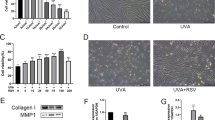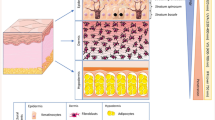Abstract
We recently found that treatment of normal human melanocytes (NHMs) with the antioxidant astaxanthin (AX) suppresses the stem cell factor (SCF)-stimulated protein expression levels of microphthalmia-associated transcription factor (MITF) at 1.5 h and of tyrosinase and endothelin B receptor at 96 h post-treatment. Analysis of the signaling cascade(s) involved revealed that although the major SCF-activated signaling cascade that leads to CREB activation (the c-KIT/Shc/Raf-1/ERK/RSK/CREB axis) is not interrupted, the increased phosphorylation of CREB is significantly abrogated by AX. We show for the first time that treatment of NHMs with SCF activates the p38/mitogen and stress-activated kinase (MSK1) axis in a c-KIT dependent fashion. Interestingly, whereas AX does not abrogate the SCF-induced activation of p38, it does affect the increased phosphorylation of its downstream target, MSK1. The lineage connection of p38/MSK1 activation with CREB activation and its associated MITF expression is supported by our finding that while silencing MSK1 abolishes the activation of CREB and the subsequent increase in total MITF proteins at 15 min and at 1.5 h, respectively, post-stimulation with SCF, inhibitors of p38 and of MSK1 abrogate the SCF-induced increase in total MITF proteins at 1.5 h post-stimulation. These findings suggest that SCF-stimulated melanogenesis can be abrogated by interrupting MSK1 phosphorylation, providing evidence for involvement of the p38/MSK1/CREB/MITF axis, providing new evidence for the ROS depletion independent interruption by antioxidants of SCF-triggered signaling.











Similar content being viewed by others
References
Blume-Jensen P, Claesson-Welsh L, Siegbahn A, Zsebo KM, Westermark B, Heldin CH (1991) Activation of the human c-kit product by ligand-induced dimerization mediates circular actin reorganization and chemotaxis. EMBO J 10(13):4121–4128
Chang LW, Juang LJ, Wang BS, Wang MY, Tai HM, Hung WJ, Chen YJ, Huang MH (2011) Antioxidant and antityrosinase activity of mulberry (Morus alba L.) twigs and root bark. Food Chem Toxicol 49(4):785–790
Cutler RL, Liu L, Damen JE, Krystal G (1993) Multiple cytokines induce the tyrosine phosphorylation of Shc and its association with Grb2 in hemopoietic cells. J Biol Chem 268(29):21463–21465
Hachiya A, Kobayashi A, Yoshida Y, Kitahara T, Takema Y, Imokawa G (2004) Biphasic expression of two paracrine melanogenic cytokines, stem cell factor and endothelin-1, in ultraviolet B-induced human melanogenesis. Am J Pathol 65(6):2099–2109
Hemesath TJ, Price ER, Takemoto C, Badalian T, Fisher DE (1998) MAP kinase links the transcription factor Microphthalmia to c-Kit signalling in melanocytes. Nature 391(6664):298–301
Hussein G, Sankawa U, Goto H, Matsumoto K, Watanabe H (2006) Astaxanthin, a carotenoid with potential in human health and nutrition. J Nat Prod 69(3):443–449
Imokawa G, Kobayasi T, Miyagishi M (2000) Intracellular signaling mechanisms leading to synergistic effects of endothelin-1 and stem cell factor on proliferation of cultured human melanocytes: cross-talk via trans-activation of the tyrosine kinase c-kit receptor. J Biol Chem 275(43):33321–33328
Imokawa G, Yada Y, Kimura M, Morisaki N (1996) Signalling mechanisms of endothelin-induced mitogenesis and melanogenesis in human melanocytes. Biochem J 314(Pt 1):305–312
Kim YH, Koh HK, Kim DS (2010) Down-regulation of IL-6 production by astaxanthin via ERK-, MSK-, and NF-κB-mediated signals in activated microglia. Int Immunopharmacol 10(12):1560–1572
Krinsky NI (1989) Antioxidant functions of carotenoids. Free Radic Bio Med 7(6):617–635
Lee SJ, Bai SK, Lee KS, Namkoong S, Na HJ, Ha KS, Han JA, Yim SV, Chang K, Kwon YG, Lee SK, Kim YM (2003) Astaxanthin inhibits nitric oxide production and inflammatory gene expression by suppressing I(kappa)B kinase-dependent NF-kappaB activation. Mol Cells 16(1):97–105
Lee YS, Chang ZQ, Oh BC, Park SC, Shin SR, Kim NW (2007) Antioxidant activity, anti-inflammatory activity, and whitening effects of extracts of Elaeagnus multiflora Thunb. J Med Food 10(1):126–133
Liu L, Damen JE, Cutler RL, Krystal G (1994) Multiple cytokines stimulate the binding of a common 145-kilodalton protein to Shc at the Grb2 recognition site of Shc. Mol Cell Biol 14(10):6926–6935
Miki W(1992) Recent advances in carotenoid studies–metabolisms and bioactivities. J Nutr Sci Vitaminol (Tokyo) 38:469–472
Mizutani Y, Hayashi N, Kawashima M, Imokawa G (2010) A single UVB exposure increases the expression of functional KIT in human melanocytes by up-regulating MITF expression through the phosphorylation of p38/CREB. Arch Dermato Res 302(4):283–294
Nakajima H, Fukazawa K, Wakabayashi Y, Wakamatsu K, Senda K, Imokawa G (2012) Abrogating effect of a xanthophyll carotenoid astaxanthin on the stem cell factor-induced stimulation of human epidermal pigmentation. Arch Dermatol Res 304(10):803–816
Nakajima H, Fukazawa K, Wakabayashi Y, Wakamatsu K, Imokawa G (2012) Withania somnifera extract attenuates stem cell factor-stimulated pigmentation in human epidermal equivalents through interruption of ERK phosphorylation within melanocytes. J Nat Med 66(3):435–446
Nakajima H, Wakabayashi Y, Wakamatsu K, Imokawa G (2011) An extract of Melia toosendan attenuates endothelin-1-stimulated pigmentation in human epidermal equivalents through the interruption of PKC activity within melanocytes. Arch Dermatol Res 303(4):263–276
Nakajima H, Wakabayashi Y, Wakamatsu K, Imokawa G (2011) An extract of Withania somnifera attenuates endothelin-1-stimulated pigmentation in human epidermal equivalents through the interruption of PKC activity within melanocytes. Phytother Res 25(9):1398–1411
Palozza P, Krinsky NI (1992) Astaxanthin and canthaxanthin are potent antioxidants in a membrane model. Arch Biochem Biophys 297(2):291–295
Potterf SB, Furumura M, Dunn KJ, Arnheiter H, Pavan WJ (2000) Transcription factor hierarchy in Waardenburg syndrome: regulation of MITF expression by SOX10 and PAX3. Hum Genet 107(1):1–6
Sato-Jin K, Nishimura EK, Akasaka E, Huber W, Nakano H, Miller A, Du J, Wu M, Hanada K, Sawamura D, Fisher DE, Imokawa G (2008) Epistatic connections between microphthalmia-associated transcription factor and endothelin signaling in Waardenburg syndrome and other pigmentary disorders. FASEB J 22(4):1155–1168
Shimidzu N (1996) Carotenoids as singlet oxygen quenchers in marine organisms. Fish Sci 62(1):134–137
Slominski A, Tobin DJ, Shibahara S, Wortsman J (2004) Melanin pigmentation in mammalian skin and its hormmonal regualtion. Physiol Rev 84(4):1155–1228
Slominski A, Zmijewski MA, Pawelek J (2012) L-tyrosine and L-dihyroxyphenylalanine as hormone-like regulators of melanocyte functions. Pigment Cell Melanoma Res 25(1):14–27
Suzuki Y, Ohgami K, Shiratori K, Jin XH, Ilieva I, Koyama Y, Yazawa K, Yoshida K, Kase S, Ohno S (2006) Suppressive effects of astaxanthin against rat endotoxin-induced uveitis by inhibiting the NF-kappaB signaling pathway. Exp Eye Res 82(2):275–281
Tagashira H, Miyamoto A, Kitamura S, Tsubata M, Yamaguchi K, Takagaki K, Imokawa G (2015) UVB stimulates the expression of endothelin B receptor in human melanocytes via a sequential activation of the p38/MSK1/CREB/MITF pathway which can be interrupted by a French maritime pine bark extract through a direct inactivation of MSK1. PLoS One 10(6):e0128678
Terazawa S, Mori S, Nakajima H, Yasuda M, Imokawa G (2015) The UVB-stimulated expression of transglutaminase 1 is mediated predominantly via the NFκB signaling pathway: New evidence of its significant attenuation through the specific interruption of the p38/MSK1/NFκBp65 Ser276 axis. PLoS One 10(8):e0136311
Terazawa S, Nakajima H, Fukasawa K, Imokawa G (2015) Withaferin A abolishes the stem cell factor-stimulated pigmentation of human epidermal equivalents by interrupting the auto-phosphorylation of c-KIT in human melanocytes. Arch Dermatol Res 307(1):73–88
Terazawa S, Nakajima H, Shingo M, Niwano T, Imokawa (2012) Astaxanthin attenuates the UVB-induced secretion of prostaglandin E2 and interleukin-8 in human keratinocytes by interrupting MSK1 phosphorylation in a ROS depletion-independent manner. Exp Dermatol 21(Suppl 1):11–17
Troppmair J, Bruder JT, App H, Cai H, Liptak L, Szeberenyi J, Cooper GM, Rapp UR (1992) Ras controls coupling of growth factor receptors and protein kinase C in the membrane to Raf-1 and B-Raf protein serine kinases in the cytosol. Oncogene 7(9):1867–1873
Wan P, Hu Y, He L (2011) Regulation of melanocyte pivotal transcription factor MITF by some other transcription factors. Mol Cell Biochem 354(1–2):241–246
Wang HM, Chen CY, Chen CY, Ho ML, Chou YT, Chang HC, Lee CH, Wang CZ, Chu IM (2010) (-)-N-Formylanonaine from Michelia alba as a human tyrosinase inhibitor and antioxidant. Bioorg Med Chem 18(14):5241–5247
Winder AJ, Harris H (1991) New assays for the tyrosine hydroxylase and dopa oxidase activities of tyrosinase. Eur J Biochem 198(2):317–326
Wood KW, Sarnecki C, Roberts TM, Blenis J (1992) Ras mediates nerve growth factor receptor modulation of three signal-transducing protein kinases: MAP kinase, Raf-1, and RSK. Cell 68(6):1041–1050
Author information
Authors and Affiliations
Corresponding author
Ethics declarations
Conflict of interest
The authors declare that they have no conflict of interest.
Ethical approval
This article does not contain any studies with human participants or animals performed by any of the authors.
Rights and permissions
About this article
Cite this article
Niwano, T., Terazawa, S., Nakajima, H. et al. The stem cell factor-stimulated melanogenesis in human melanocytes can be abrogated by interrupting the phosphorylation of MSK1: evidence for involvement of the p38/MSK1/CREB/MITF axis. Arch Dermatol Res 310, 187–196 (2018). https://doi.org/10.1007/s00403-018-1816-x
Received:
Revised:
Accepted:
Published:
Issue Date:
DOI: https://doi.org/10.1007/s00403-018-1816-x




